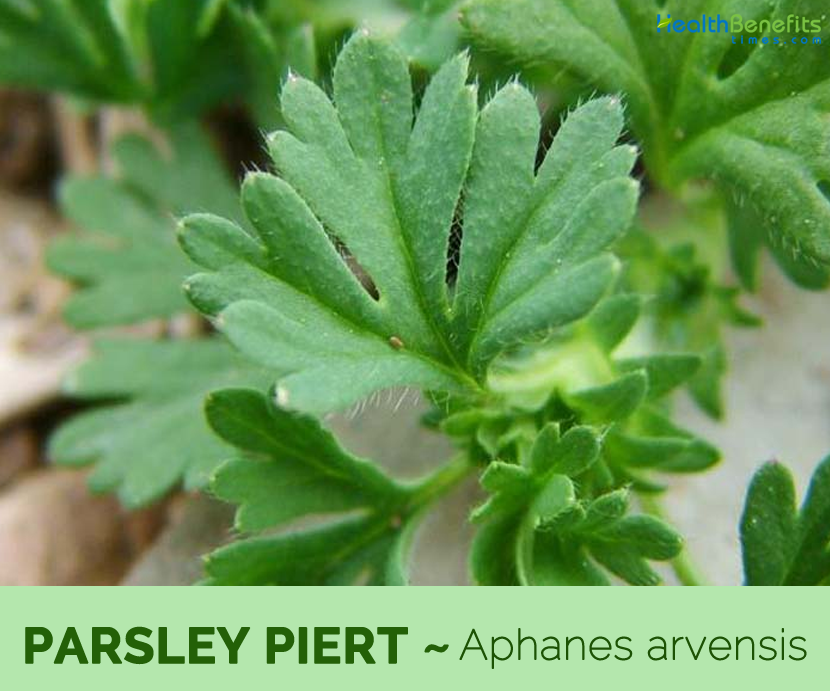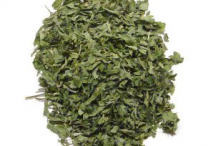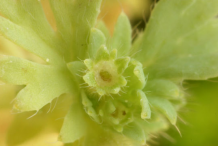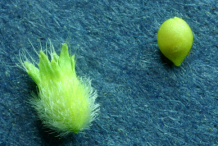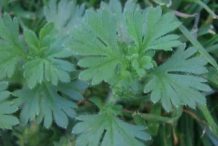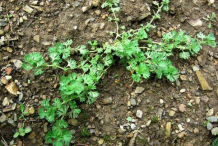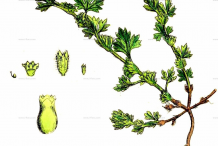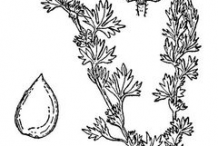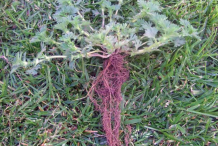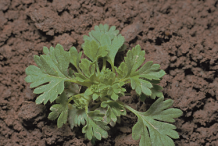It is no relation to true parsley, but its leaves look similar. It is a close relation to Lady’s Mantle, hence the name Lady’s Field Mantle. It is also called Parsley Break-stone, from its efficacy in dissolving stone in the bladder. The genus name of Aphanes comes from a Greek word meaning unseen or unnoticed, which just describes this tiny plant. However, parsley piert is a very common and widespread weed of cultivated ground, whether acidic or not. Parsley Piert is an herbal medicine used to treat kidney stones, infections, and to help soothe and heal cuts and scratches. It may also soothe the linings of the kidneys and intestines and act as a diuretic (increases water loss).
Plant
Parsley piert is a free branched, sprawling, downy plant that grows about 2 to 30 cm long and are dull green in color. The plant is found growing in residential and institutional lawns, athletic fields, sod farms, golf course fairways and roughs, roadsides, utility right-of-ways, railways, and industrial areas. Normally it prefers well-drained soil and can grow in nutritionally poor soil. It can also grow in very acid and very alkaline soils. Root is thin, branched and fusiform and stem is generally branched and decumbent, with short internodes. Sometimes prostrate, but generally erect, and much branched from the base.
Leaves
Leaves are dusky green color, wedge-shaped, three-cleft, the lobes deeply cut, the whole leaf less than 1/2 inch wide, narrowed into a short foot-stalk with leafy, palmately-cut stipules, sheathing and cleaving to the footstalk. The whole plant is downy with slender, scattered hairs. Leaves are only 2–10 mm long.
Flower & Fruit
The flowers are in axillary clusters of 10 to 20. They are surrounded by stipules. Sepals are erect, acuminate-ovate and pubescent on the outside and on the margins. They are glabrous on the inside and draw together when the fruit ripens. Flowering normally takes place from Jul to November. Fruit is 1 mm long, ovate, keeled, flat and jug-shaped. The calyx is vertically wrinkled and pubescent.
Common Uses of parsley piert herb
- Bladder inflammation
- Bladder stones
- Kidney problems
- Recurrent urinary tract infections
- Swelling caused by kidney of liver problems
- Urinary problems
Traditional uses and benefits of Parsley piert
- Parsley piert has a long history of folk use, being commonly employed to rid the body of stones in the kidney or bladder.
- It has become a highly respected herb in modern herbalism for the treatment of kidney stones.
- Whole herb is astringent, demulcent, diuretic and refrigerant.
- It is used mainly as an infusion in the treatment of kidney and bladder complaints (including cystitis and recurrent urinary infections), jaundice etc.
- Kidney stones can be treated by administering a combo of Stone root, Parsley Piert, Gravel root, Parietaria judaica, Hydrangea.
- It is used in folk remedies in the treatment of urinary tract disorders.
- It is beneficial in all cases of painful urination.
- It may be used where there is water retention, particularly where this is due to kidney or liver problems.
- People take parsley piert for fever, kidney stones, bladder stones, and fluid retention.
Culinary Uses
- Leaves are eaten raw in salads or pickled for winter use.
- The plant is rarely eaten nowadays.
Usual dose for Parsley-piert
- Tea: The recommended dose is 3-4 cups a day.
- Tincture: The recommended dose is 2-4ml, 3 times a day.
- Liquid extract: The recommended dose is 2-4ml orally, 3 times a day.
- Dried herb: The recommended dose is 2-4mg orally.
The dose for this herbal supplement may be different for every patient. The dose that you take depends on your age, health, and several other conditions. Herbal supplements are not always safe. Please discuss with your herbalist or doctor for your appropriate dosage.
Precautions
- Avoid use during Pregnancy and breastfeeding.
- Parsley-piert may cause side effects, such as Breathing problems, Tightness in your throat or chest, Chest pain and Skin hives, rash, or itchy or swollen skin.
- Call your health care practitioner if you experience unusual symptoms while using parsley piert.
- Combining herbs with certain drugs may alter their action or produce unwanted side effects.
- You shouldn’t use this herb until you know more about its safety and effectiveness.
References:
https://www.itis.gov/servlet/SingleRpt/SingleRpt?search_topic=TSN&search_value=184592#null
https://davesgarden.com/guides/pf/go/58411/
https://npgsweb.ars-grin.gov/gringlobal/taxonomydetail.aspx?id=316983
http://www.pfaf.org/User/Plant.aspx?LatinName=Aphanes+arvensis
http://www.floracatalana.net/aphanes-arvensis-l-
http://www.theplantlist.org/tpl1.1/record/rjp-34
https://plants.usda.gov/core/profile?symbol=apar2
https://en.wikipedia.org/wiki/Aphanes_arvensis
https://www.allinahealth.org/CCS/doc/Thomson%20Alternative%20Medicine/48/10130.htm
http://www.botanical.com/botanical/mgmh/p/parpie11.html
http://www.purplesage.org.uk/profiles/parsleypiert.htm
Comments
| Parsley Piert Quick Facts | |
|---|---|
| Name: | Parsley Piert |
| Scientific Name: | Aphanes arvensis |
| Origin | Europe, North Africa and western Asia and has been introduced to North America |
| Shapes | 1 mm long, ovate, keeled, flat and jug-shaped |
| Taste | Astringent |
| Name | Parsley Piert |
|---|---|
| Scientific Name | Aphanes arvensis |
| Native | Europe, North Africa and western Asia and has been introduced to North America |
| Common Names | Field Parsley Piert, Parsley Breakstone, Parsley Piercestone, Field Lady’s Mantle, Alchemilla arvensis Scop, Field Lady’s Mantle, Parsley Breakstone, Aphanes arvensis |
| Name in Other Languages | Dutch: Grote leeuwenklauw English: Field parsley piert, parsley piert Finnish: Peltopoimukki, Peltopoimulehti French: Alchémille des champs, Aphane des champs German: Acker-Sinau |
| Plant Growth Habit | Free branched, sprawling, downy plant |
| Growing Climate | Residential and institutional lawns, athletic fields, sod farms, golf course fairways and roughs, roadsides, utility right-of-ways, railways, and industrial areas |
| Soil | Prefers well-drained soil and can grow in nutritionally poor soil. It can also grow in very acid and very alkaline soils. |
| Plant Size | 2 to 30 cm long and dull green in color |
| Root | Thin, branched and fusiform |
| Stem | Branched and decumbent, with short internodes. Sometimes prostrate, but generally erect, and much branched from the base |
| Leaf | Dusky green color, wedge-shaped, three-cleft, the lobes deeply cut, the whole leaf less than 1/2 inch wide, narrowed into a short foot-stalk with leafy, palmately-cut stipules, sheathing and cleaving to the footstalk. The whole plant is downy with slender, scattered hairs. leaves only 2–10 mm long |
| Flowering Periods | Jul to November |
| Flower | Flowers are in axillary clusters of 10 to 20. They are encircled by stipules. The sepals are erect, acuminate-ovate and pubescent on the outside and on the margins. They are glabrous on the inside and draw together when the fruit ripens. |
| Fruit | Fruit is 1 mm long, ovate, keeled, flat and jug-shaped. The calyx is vertically wrinkled and pubescent. |
| Flavor/Aroma | No odour |
| Taste | Astringent |
| Plant Parts Used | Whole Plant |
| Available Forms | Capsule, Tablet, Tincture, Liquid extract, Dried herb |


